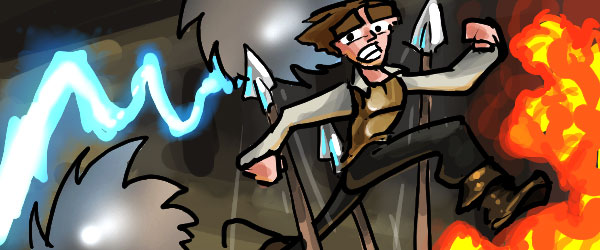Or: Mortality & Happenstance via Mechanical Means
Traps are a bit of a conundrum because it’s not generally good game design to aggravate the player by having them randomly die. Aye, The Grand Tradition of dungeon crawlers demands traps in some form, but they pose the problem of being hidden surprise! damage-dealers. If a player is walking along and gets offed by a Dwarven land mine, hilarious though it may be to randomly explode, their agency has been taken away and this is frustrating to a player.
What is one to do with traps? Read on!

Well, we need to define a gameplay role for traps that results only occasionally in instant surprise-death.
Consider: traps can act like “dangerous terrain”. Navigating dangerous terrain should be a trade-off. Safety and convenience is sacrificed for getting across that tile no matter what. It should be an act the player chooses to perform – though if careless, one they can run themselves into. But, importantly, it’ll be a player’s own fault for not watching the warning signs, not the failure of a “spot trap” roll.
Other Games’ Approach
I recall a particular trap in one of the Baldur’s Gate games which turned one of my party members to stone for attempting to open a door – it was awful, but perhaps just permissible in a game that is played with six player-controlled characters. This is not something Dredmor can do to the player, no matter what the spirit of old school roguelikes implies. I know what you’ll say, but “Losing is fun” is a very delicate sell – it depends on what is lost, and how interesting that loss is in the losing. Losing Dwarf Fortress may provide a wonderful story of some catastrophe with ensuing social chaos, madness, and violence. Meanwhile, we just have one character who will keel over; There’s little narrative there.
Remember traps in Half-life1/2? Every environmental danger was demonstrated to the player, the consequences clearly shown upon a hapless NPC before the player would have to deal with the danger themself. The game gave the player agency: the lesson was taught first, then the test given.
Diablo’s approach (and Diablo must be examined as a wildly successful hack & slash) was to make traps essentially irrelevant, barely annoyances that just dealt a little damage to the player. I’m not sure that they could have successfully done otherwise in such a fast-paced game. The theme of traps was in the game, but extremely weak. I think we should do better than nerfing traps beyond meaning.
Some off-the-cuff imperatives:
- Don’t randomly insta-kill the player. It isn’t fun.
- Provide agency. If the player is killed, it was their own fault for not paying attention to information they were given.
- Weak traps are thematically weak.
How to Negotiate With Traps
One thought was to have some disarming minigames ala Bioshock (or Minesweeper?) or the various activities in Oblivion. A counterpoint is raised by actually having the misfortune of playing the minigames in Oblivion. What is the purpose of a smaller, simpler, much less fun game disconnected from most of the other mechanics? Surely it’d be much more interesting if the mechanics of other game systems were allowed to interfere.
Rather than performing a rote solution algorithm on what could be a very poor Flash game, why not integrate the ‘minigame’ into the tactical field of the dungeon grid where the main body of Dredmor gameplay takes place? Now things can get interesting! — Say you were negotiating a room filled with traps when a vicious pack of Carroty-monsters fell upon you? Why, it could be lovely! (And with the proper skill loadout and tactical use of space, you could end up with some delicious vegetable platters with dip).
Each class archetype can have a different way of dealing with traps with the Rogue having the most control, what with traps being a Rogue-themed hazard. So:
- A Warrior will be strong and heavily-armored enough to simply Take It Like A Man – in moderation. As a warrior on a reasonable dungeon level for the player’s level, any trap should be survivable when at a decent level of health.
- A Wizard could have various spells to deal with traps – teleportation around them, fireballs to blow them up, a boring defensive spell to defend against them; whatever works.
- A Rogue could have a special trap disarming skill that lets the player take the trap and reset it wherever they like. Or they dodge it like a ninja.
- Various items can substitute for the above methods: A magic ring could protect a player against the fire damage from a fire trap, an exploding bolt could clear any old trap, and maybe some rocket boots will let the player move over the trap … yeah! Or something.
In all, the key here is to hold up traps to the most fundamental unit of Dredmor’s gameplay: Tiles. It’s all about what’s on them, what you choose to do with them, and where you choose to do it. Also when. And how.
You get the idea.

Completely agree with this. I like this as long as there are still some hidden surprises, however. A good compromise, if you’ve played Dungeon Crawl (if you did, feel free to correct me as I’ve never actually gotten to the end game of that one) the traps were never really fatal. Annoying, yes, but rarely fatal if you were careful.
Yes. I agree too. I remember that one time I died i ADOM when i was opening my first door. Never got a chance to even see a monster. Traps should change a condition of a player rather than killing him. Poison, disease, blindness, criple, etc.
I quite like that – instead of opening a door as a task’s end point, opening the door creates an imperative for the player to deal with some sort of consequences in their own dynamic, discovered manner.
Neat!